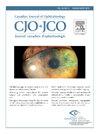Impact of 5 waves of COVID-19 on pediatric ophthalmology
IF 3.3
4区 医学
Q1 OPHTHALMOLOGY
Canadian journal of ophthalmology. Journal canadien d'ophtalmologie
Pub Date : 2024-08-03
DOI:10.1016/j.jcjo.2024.06.018
引用次数: 0
Abstract
Objective
To characterize the impact of multiple waves of COVID-19 on pediatric ophthalmology at a tertiary care hospital.
Methods
Medical records were reviewed from pediatric patients seen for ophthalmic emergencies at the Montreal Children's Hospital (Montreal, Canada) from 5 COVID-19 periods: March 13 to May 31, 2020; September 20, 2020, to February 21, 2021; March 21 to May 31, 2021; August 17 to November 5, 2021; and December 19, 2021, to January 25, 2022, as well as 2 pre-COVID time periods: March 13 to May 31, in 2018 and 2019).
Results
There was a significant reduction in ophthalmic consultations when comparing pre-COVID to all 5 COVID waves (p < 0.0001). There was an increase in the average number of daily urgent (p = 0.01) ophthalmic consultations from waves 1 to 4. Mean household income of patients was not significantly different pre-COVID compared to during the 5 COVID waves (p = 0.96). The most common referral reason was ocular trauma (38.0% of cases). There was a non-significant trend demonstrating more infectious disease presentations during waves 3 to 5 (p = 0.07). There was no difference in symptom duration prior to presentation (p = 0.54); however, there was a difference in the time between emergency room and ophthalmology assessment in waves 3 and 4 compared with wave 5 (p = 0.003).
Conclusion
The number of pediatric ophthalmology consultations was less during the 5 COVID waves than pre-COVID. An increase in urgent pediatric ophthalmology consultations occurred as COVID-19 infection rates in Quebec decreased. Access to health care and time to care were preserved across waves compared with pre-pandemic.
Objectif
Dépeindre les conséquences des multiples vagues de COVID-19 sur l'ophtalmologie pédiatrique dans un hôpital de soins tertiaires.
Méthodes
On a examiné les dossiers médicaux d'enfants qui ont été vus au service des urgences ophtalmologiques à l'Hôpital de Montréal pour enfants (Montréal, Canada) pendant 5 vagues de COVID-19 : du 13 mars au 31 mai 2020; du 20 septembre 2020 au 21 février 2021; du 21 mars au 31 mai 2021; du 17 août au 5 novembre 2021 et du 19 décembre 2021 au 25 janvier 2022, de même que pendant 2 périodes avant la COVID-19, soit du 13 mars au 31 mai 2018 et 2019.
Résultats
Il s'est produit une baisse significative des consultations en ophtalmologie pendant les 5 vagues de COVID-19, comparativement aux 2 périodes avant la COVID-19 (p < 0,0001). On a enregistré une hausse du nombre quotidien moyen de consultations d'urgence au service d'ophtalmologie (p = 0,01) de la première à la quatrième vague. Le revenu du ménage moyen des patients ne différait pas significativement avant la COVID-19, comparativement au revenu pendant les 5 vagues de COVID-19 (p = 0,96). Le motif de consultation le plus fréquent était un traumatisme oculaire (38,0 % des cas). On a dégagé une tendance non significative selon laquelle le nombre d'atteintes de nature infectieuse était plus élevé pendant les vagues 3 à 5 (p = 0,07). On n'a pas observé de différence d'une période à l'autre quant à la durée des symptômes avant la consultation (p = 0,54); on a toutefois noté une différence entre le temps passé au service des urgences et l’évaluation ophtalmologique pendant les vagues 3 et 4, comparativement à la cinquième vague (p = 0,003).
Conclusion
Le nombre de consultations en ophtalmologie pédiatrique a été plus bas pendant les 5 vagues de COVID-19 qu'avant la pandémie. On a noté une hausse des visites d'urgence en ophtalmologie pédiatrique à mesure que diminuait le taux d'infection à la COVID-19 au Québec. L'accès aux soins de santé et le délai avant de rencontrer un spécialiste se sont maintenus pendant les vagues de COVID-19, comparativement aux données précédant la pandémie.
5 波 COVID-19 对小儿眼科的影响。
目的分析 COVID-19 对一家三级医院儿科眼科的影响:对蒙特利尔儿童医院(加拿大蒙特利尔)因眼科急诊就诊的儿科患者在 5 个 COVID-19 期间的医疗记录进行审查:2020年3月13日至5月31日;2020年9月20日至2021年2月21日;2021年3月21日至5月31日;2021年8月17日至11月5日;2021年12月19日至2022年1月25日,以及COVID前的2个时间段:结果:结果:与 COVID 前相比,眼科就诊人数明显减少(p < 0.0001)。从第 1 波到第 4 波,眼科日均急诊次数有所增加(p = 0.01)。与 COVID 的 5 波相比,COVID 前患者的平均家庭收入没有明显变化(p = 0.96)。最常见的转诊原因是眼外伤(占 38.0%)。第 3 波至第 5 波期间出现更多感染性疾病病例的趋势并不显著(p = 0.07)。发病前的症状持续时间没有差异(p = 0.54);但是,第 3 和第 4 波与第 5 波相比,急诊室与眼科评估之间的时间存在差异(p = 0.003):结论:在 COVID 的 5 个波次中,小儿眼科就诊次数少于 COVID 前。随着魁北克 COVID-19 感染率的降低,小儿眼科急诊数量也有所增加。与疫情爆发前相比,各次疫情中获得医疗服务的机会和就诊时间均保持不变。
本文章由计算机程序翻译,如有差异,请以英文原文为准。
求助全文
约1分钟内获得全文
求助全文
来源期刊
CiteScore
3.20
自引率
4.80%
发文量
223
审稿时长
38 days
期刊介绍:
Official journal of the Canadian Ophthalmological Society.
The Canadian Journal of Ophthalmology (CJO) is the official journal of the Canadian Ophthalmological Society and is committed to timely publication of original, peer-reviewed ophthalmology and vision science articles.

 求助内容:
求助内容: 应助结果提醒方式:
应助结果提醒方式:


